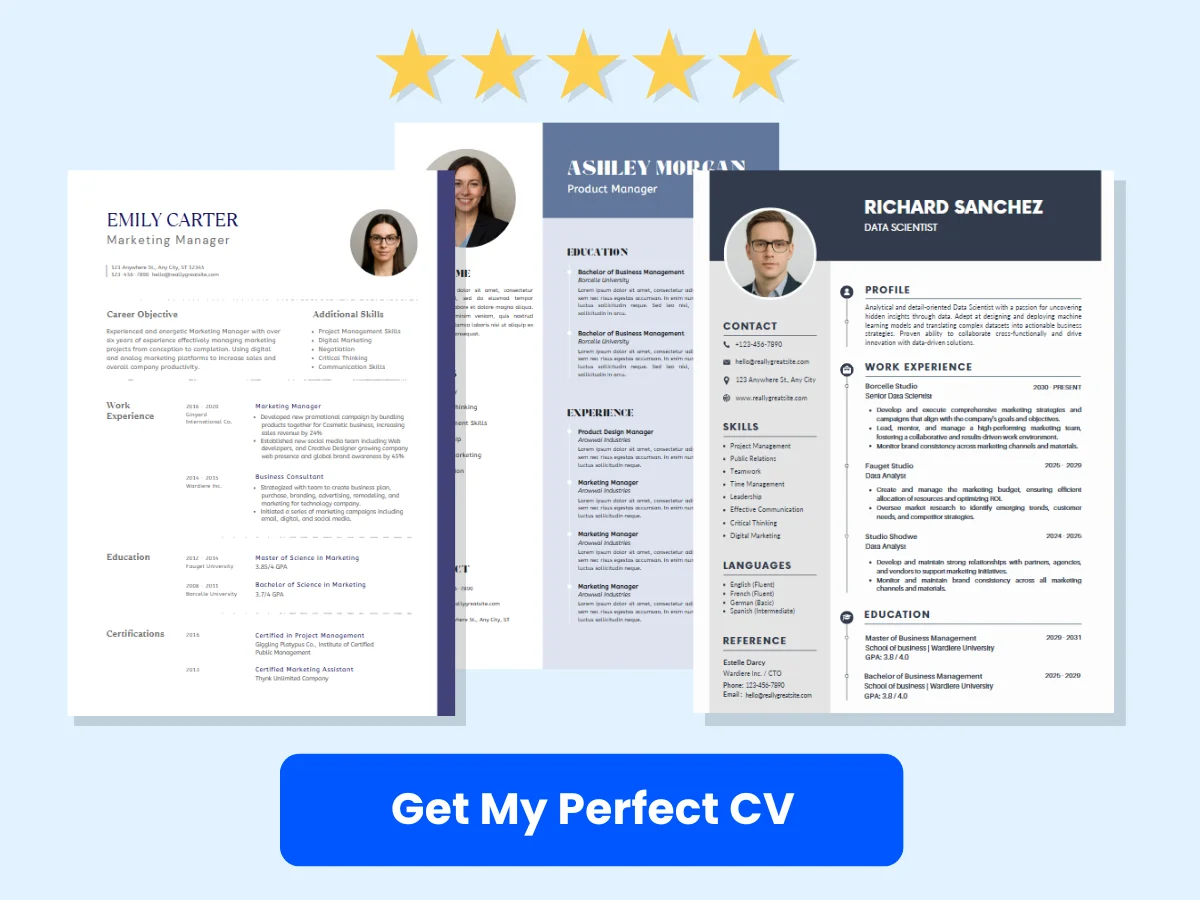In the competitive field of occupational therapy, a well-crafted CV is your first opportunity to make a lasting impression on potential employers. As a professional dedicated to enhancing the quality of life for individuals through therapeutic practices, showcasing your skills, experience, and passion effectively is crucial. This article delves into five exemplary CVs tailored specifically for occupational therapists, providing you with a comprehensive guide to crafting your own standout resume.
Understanding the nuances of CV writing can significantly impact your job search success. Whether you are a seasoned practitioner or a recent graduate, the right format, language, and presentation can set you apart in a crowded job market. Throughout this article, you will discover key elements that make a CV compelling, tips for highlighting your unique qualifications, and insights into common pitfalls to avoid.
By the end of this guide, you will not only have access to practical examples but also the knowledge to tailor your CV to reflect your individual journey in occupational therapy. Prepare to elevate your professional profile and take the next step in your career with confidence!
Exploring the Role of an Occupational Therapist
Key Responsibilities and Duties
Occupational therapists (OTs) play a crucial role in helping individuals achieve independence in their daily lives. They work with clients of all ages who may be experiencing physical, emotional, or developmental challenges. The primary goal of an occupational therapist is to enable clients to participate in meaningful activities, or “occupations,” that enhance their quality of life. Below are some of the key responsibilities and duties that OTs typically undertake:
- Assessment and Evaluation: OTs begin by conducting comprehensive assessments to understand the client’s needs, strengths, and challenges. This may involve standardized tests, interviews, and observations to evaluate the client’s physical, cognitive, and emotional capabilities.
- Developing Treatment Plans: Based on the assessment results, occupational therapists create individualized treatment plans that outline specific goals and interventions. These plans are tailored to the client’s unique circumstances and may include therapeutic activities, adaptive equipment recommendations, and environmental modifications.
- Implementing Interventions: OTs implement various therapeutic interventions designed to improve the client’s ability to perform daily activities. This may include exercises to enhance strength and coordination, cognitive training to improve memory and problem-solving skills, or teaching clients how to use assistive devices.
- Monitoring Progress: Occupational therapists regularly monitor and document the client’s progress towards their goals. This involves adjusting treatment plans as necessary to ensure that the interventions remain effective and relevant to the client’s evolving needs.
- Collaboration with Other Professionals: OTs often work as part of a multidisciplinary team, collaborating with physicians, physical therapists, speech-language pathologists, and social workers to provide comprehensive care. Effective communication and teamwork are essential to ensure that all aspects of the client’s health and well-being are addressed.
- Education and Advocacy: Occupational therapists educate clients and their families about the therapeutic process, self-care strategies, and community resources. They also advocate for their clients’ needs within healthcare systems and may engage in public awareness campaigns to promote the importance of occupational therapy.
Essential Skills and Competencies
To be effective in their roles, occupational therapists must possess a diverse set of skills and competencies. These skills not only enhance their ability to provide quality care but also contribute to positive client outcomes. Here are some essential skills that OTs should develop:


- Clinical Skills: A strong foundation in clinical skills is vital for OTs. This includes knowledge of anatomy, physiology, and various therapeutic techniques. OTs must be adept at conducting assessments and implementing evidence-based interventions.
- Communication Skills: Effective communication is key in occupational therapy. OTs must be able to clearly convey information to clients, families, and other healthcare professionals. This includes active listening, empathy, and the ability to explain complex concepts in an understandable manner.
- Problem-Solving Skills: Occupational therapists often encounter unique challenges with each client. Strong problem-solving skills enable OTs to develop creative solutions that address individual needs and adapt interventions as necessary.
- Patience and Compassion: Working with clients who may be facing significant challenges requires a high level of patience and compassion. OTs must be able to provide emotional support and encouragement, fostering a positive therapeutic relationship.
- Organizational Skills: OTs manage multiple clients and treatment plans simultaneously. Strong organizational skills are essential for keeping track of assessments, progress notes, and scheduling sessions effectively.
- Cultural Competence: Understanding and respecting diverse cultural backgrounds is crucial in occupational therapy. OTs must be culturally competent to provide care that is sensitive to the values, beliefs, and practices of their clients.
Educational and Certification Requirements
Becoming an occupational therapist requires a significant investment in education and training. The pathway to this rewarding career typically involves the following steps:
- Educational Background: To pursue a career in occupational therapy, candidates must first obtain a bachelor’s degree. While there is no specific major required, degrees in psychology, biology, or health sciences can provide a strong foundation. Following the undergraduate degree, aspiring OTs must complete a master’s or doctoral program in occupational therapy accredited by the Accreditation Council for Occupational Therapy Education (ACOTE).
- Fieldwork Experience: As part of their education, occupational therapy students are required to complete supervised fieldwork experiences. This hands-on training allows students to apply their knowledge in real-world settings, working with clients under the guidance of licensed OTs. Fieldwork typically consists of two levels, with each level requiring a minimum number of hours in various practice settings.
- Certification: After completing their educational and fieldwork requirements, graduates must pass the National Board for Certification in Occupational Therapy (NBCOT) exam to become a licensed occupational therapist. This certification is essential for practicing in most states and is a testament to the individual’s knowledge and competency in the field.
- State Licensure: In addition to national certification, OTs must obtain a state license to practice. Each state has its own licensing requirements, which may include additional exams or continuing education credits. It is important for OTs to stay informed about the regulations in their state of practice.
- Continuing Education: Occupational therapy is a dynamic field that continually evolves with new research and practices. OTs are required to engage in continuing education to maintain their licensure and stay current with advancements in the profession. This may involve attending workshops, conferences, or pursuing additional certifications in specialized areas of practice.
The role of an occupational therapist is multifaceted, requiring a blend of clinical expertise, interpersonal skills, and a commitment to lifelong learning. By understanding the key responsibilities, essential skills, and educational requirements, aspiring OTs can better prepare themselves for a fulfilling career dedicated to improving the lives of others.
General CV Writing Tips for Occupational Therapists
Structuring Your CV
Creating a well-structured CV is essential for occupational therapists looking to make a strong impression on potential employers. A clear and organized layout not only enhances readability but also allows hiring managers to quickly identify your qualifications and experience. Here’s how to structure your CV effectively:
- Contact Information: Start with your full name, phone number, email address, and LinkedIn profile (if applicable). Ensure that your email address is professional, ideally a combination of your first and last name.
- Professional Summary: This section should be a brief overview of your qualifications, experience, and career goals. Aim for 2-3 sentences that highlight your key skills and what you bring to the table as an occupational therapist.
- Education: List your educational background in reverse chronological order. Include the name of the institution, degree obtained, and graduation date. If you have relevant certifications (e.g., NBCOT certification), include them here as well.
- Work Experience: This is the most critical section of your CV. List your work experience in reverse chronological order, including your job title, the name of the organization, location, and dates of employment. Use bullet points to describe your responsibilities and achievements, focusing on quantifiable results where possible.
- Skills: Highlight specific skills relevant to occupational therapy, such as patient assessment, treatment planning, and knowledge of therapeutic modalities. Consider including both hard and soft skills, such as communication and teamwork.
- Professional Affiliations: If you are a member of any professional organizations (e.g., American Occupational Therapy Association), list them here. This demonstrates your commitment to the field and ongoing professional development.
- Continuing Education: Include any additional training, workshops, or certifications that enhance your qualifications. This shows your dedication to staying current in the field.
- References: You can either list references directly on your CV or state that they are available upon request. Ensure that your references are aware and willing to provide a recommendation.
Tailoring Your CV to the Job Description
One of the most effective ways to stand out in a competitive job market is to tailor your CV to each specific job application. This means customizing your CV to align with the job description and the skills and experiences that the employer is seeking. Here are some strategies to help you tailor your CV effectively:
- Analyze the Job Description: Carefully read the job description and highlight key responsibilities and required skills. Take note of any specific qualifications or experiences that are emphasized.
- Match Your Experience: When listing your work experience, prioritize the roles and responsibilities that align most closely with the job you are applying for. Use similar language and terminology found in the job description to demonstrate that you are a good fit.
- Highlight Relevant Skills: If the job description mentions specific skills (e.g., experience with pediatric therapy or knowledge of assistive technology), ensure these are prominently featured in your skills section and supported by examples in your work experience.
- Use Keywords: Many employers use Applicant Tracking Systems (ATS) to screen CVs. Incorporate relevant keywords from the job description into your CV to increase the chances of passing through these systems. This includes specific terms related to occupational therapy practices, tools, and methodologies.
- Customize Your Professional Summary: Tailor your professional summary to reflect the specific role you are applying for. Mention the organization’s name and how your goals align with their mission, which shows genuine interest in the position.
Common Mistakes to Avoid
When crafting your CV, it’s crucial to avoid common pitfalls that can detract from your qualifications and professionalism. Here are some mistakes to watch out for:
- Using a Generic CV: Sending out the same CV for every job application is a missed opportunity. Employers can easily spot a generic CV, which may suggest a lack of effort or interest in the specific position.
- Overloading with Information: While it’s important to provide enough detail about your experience, avoid overwhelming the reader with excessive information. Keep your CV concise, ideally one to two pages, and focus on the most relevant experiences and skills.
- Neglecting Formatting: A cluttered or poorly formatted CV can be off-putting. Use consistent fonts, bullet points, and spacing to create a clean and professional appearance. Ensure that your CV is easy to read and visually appealing.
- Including Irrelevant Information: Avoid adding personal details that are not relevant to the job, such as age, marital status, or hobbies that do not relate to occupational therapy. Focus on professional qualifications and experiences that showcase your suitability for the role.
- Typos and Grammatical Errors: Spelling and grammatical mistakes can undermine your professionalism. Always proofread your CV multiple times and consider asking a colleague or mentor to review it as well.
- Being Vague: Use specific examples and quantifiable achievements to demonstrate your impact in previous roles. Instead of saying, “I helped improve patient outcomes,” specify how you did this, such as “Implemented a new therapy program that increased patient mobility by 30% over six months.”
- Ignoring the Cover Letter: While the CV is crucial, don’t overlook the importance of a well-crafted cover letter. This is your opportunity to provide context for your CV and explain why you are particularly suited for the role.
By following these general CV writing tips, occupational therapists can create a compelling and professional CV that effectively showcases their qualifications and increases their chances of landing an interview. Remember, your CV is often the first impression you make on potential employers, so take the time to ensure it reflects your best self.


Detailed Breakdown of CV Sections
Contact Information
Your CV begins with your contact information, which is crucial for potential employers to reach you. This section should be clear and concise, typically positioned at the top of your CV. Include the following:
- Full Name: Use your professional name as it appears on your credentials.
- Phone Number: A reliable number where you can be reached.
- Email Address: Use a professional email address, ideally a combination of your first and last name.
- LinkedIn Profile: If applicable, include a link to your LinkedIn profile to provide additional professional context.
- Location: City and state are sufficient; you don’t need to include your full address for privacy reasons.
What to Include
In addition to your contact information, your CV should include several key sections that highlight your qualifications and experiences. These sections typically include:
- Professional Summary
- Work Experience
- Education and Certifications
- Skills Section
- Additional Sections (such as Volunteer Experience, Professional Affiliations, and Continuing Education)
Formatting Tips
Formatting your CV correctly is essential for readability and professionalism. Here are some tips to ensure your CV is well-structured:
- Font Choice: Use a clean, professional font such as Arial, Calibri, or Times New Roman. Keep the font size between 10-12 points.
- Headings: Use bold or larger font sizes for section headings to make them stand out.
- Bullet Points: Use bullet points for lists to enhance readability and allow for quick scanning of information.
- Consistent Formatting: Ensure that your formatting is consistent throughout the document, including font sizes, bullet styles, and spacing.
- Length: Aim for a CV length of one to two pages, depending on your experience level.
Professional Summary
The professional summary is a brief section that provides an overview of your qualifications, experience, and career goals. It should be tailored to the specific job you are applying for and highlight your most relevant skills and experiences.
Crafting a Compelling Summary
To craft a compelling professional summary, consider the following tips:


- Be Concise: Aim for 3-5 sentences that summarize your professional background.
- Use Keywords: Incorporate keywords from the job description to align your summary with the employer’s needs.
- Showcase Your Value: Highlight what makes you a strong candidate, such as years of experience, specific skills, or notable achievements.
Examples of Effective Summaries
Here are a few examples of effective professional summaries for occupational therapists:
- Example 1: “Dedicated Occupational Therapist with over 5 years of experience in pediatric rehabilitation. Proven track record of developing individualized treatment plans that enhance patient mobility and independence. Passionate about using evidence-based practices to improve patient outcomes.”
- Example 2: “Compassionate and results-driven Occupational Therapist with expertise in geriatric care. Skilled in assessing patient needs and implementing therapeutic interventions that promote recovery and enhance quality of life. Committed to continuous professional development and patient advocacy.”
- Example 3: “Dynamic Occupational Therapist with a strong background in mental health and community-based rehabilitation. Adept at collaborating with multidisciplinary teams to create holistic treatment plans. Recognized for exceptional communication skills and a patient-centered approach.”
Work Experience
The work experience section is one of the most critical parts of your CV. It provides potential employers with insight into your professional background and the skills you have developed over time.
How to List Your Experience
When listing your work experience, follow these guidelines:
- Reverse Chronological Order: Start with your most recent position and work backward.
- Job Title: Clearly state your job title to give context to your role.
- Company Name and Location: Include the name of the organization and its location (city and state).
- Dates of Employment: Specify the month and year you started and ended each position.
- Bullet Points: Use bullet points to describe your responsibilities and achievements in each role.
Highlighting Key Achievements
In addition to listing your responsibilities, it’s essential to highlight your key achievements. This can set you apart from other candidates. Consider the following:
- Quantify Your Achievements: Use numbers to demonstrate your impact, such as “Increased patient satisfaction scores by 20% through improved therapy techniques.”
- Use Action Verbs: Start each bullet point with strong action verbs like “developed,” “implemented,” “collaborated,” or “assessed.”
- Focus on Outcomes: Highlight how your contributions positively affected patients or the organization, such as “Successfully reduced patient recovery time by 15% through targeted intervention strategies.”
Education and Certifications
Your educational background and certifications are vital components of your CV, especially in a regulated profession like occupational therapy.
Listing Your Educational Background
When listing your education, include the following:


- Degree Earned: Specify the degree (e.g., Master of Occupational Therapy, Bachelor of Science in Occupational Therapy).
- Institution Name: Include the name of the university or college.
- Graduation Date: Provide the month and year of graduation.
Example:
Master of Occupational Therapy
University of Health Sciences, City, State
Graduated: May 2020
Relevant Certifications and Licenses
In addition to your degree, list any relevant certifications and licenses. This may include:
- State Licensure: Include your occupational therapy license number and the state where you are licensed.
- Specialty Certifications: Mention any additional certifications, such as Certified Hand Therapist (CHT) or Pediatric Occupational Therapist (POT).
Example:
Licensed Occupational Therapist (OTR/L)
State of [Your State], License #123456
Certified Hand Therapist (CHT)
Certification #789012
Skills Section
The skills section of your CV is where you can showcase both your hard and soft skills relevant to occupational therapy.


Hard Skills vs. Soft Skills
Hard skills are specific, teachable abilities that can be defined and measured, while soft skills are more subjective and relate to how you work with others. For occupational therapists, both types of skills are essential.
- Hard Skills: Examples include knowledge of therapeutic techniques, patient assessment, and familiarity with rehabilitation equipment.
- Soft Skills: Examples include communication, empathy, problem-solving, and teamwork.
How to Showcase Your Skills
When showcasing your skills, consider the following:
- Be Specific: Instead of listing generic skills, provide specific examples of how you have applied these skills in your work.
- Use a Combination: Include a mix of hard and soft skills to present a well-rounded profile.
- Tailor to the Job: Align your skills with the requirements listed in the job description to demonstrate your fit for the position.
Additional Sections
Including additional sections in your CV can provide a more comprehensive view of your qualifications and experiences.
Volunteer Experience
Highlighting volunteer experience can demonstrate your commitment to the field and your ability to work with diverse populations. List any relevant volunteer roles, including:


- Organization Name: The name of the organization where you volunteered.
- Role: Your title or role during the volunteer work.
- Dates: The duration of your volunteer work.
- Responsibilities: Briefly describe your contributions and any skills you developed.
Professional Affiliations
Membership in professional organizations can enhance your credibility and show your commitment to ongoing professional development. Include:
- Organization Name: The name of the professional organization.
- Membership Type: Specify if you are a member, associate, or fellow.
- Years Active: The duration of your membership.
Continuing Education and Workshops
Continuing education is vital in the healthcare field, especially in occupational therapy. List any relevant workshops, seminars, or courses you have completed, including:
- Course Title: The name of the course or workshop.
- Provider: The organization or institution that offered the course.
- Date Completed: The month and year you completed the course.
Example:
Advanced Therapeutic Techniques Workshop
Offered by: [Provider Name]
Completed: June 2022
Occupational Therapist CV Examples
Example 1: Entry-Level Occupational Therapist
An entry-level occupational therapist CV is designed to showcase the candidate’s education, internships, and any relevant volunteer experiences. This CV should highlight the foundational skills and knowledge acquired during their training, as well as any hands-on experience gained through clinical placements.


Overview and Key Features
- Contact Information: Clearly listed at the top, including name, phone number, email, and LinkedIn profile.
- Objective Statement: A brief statement that outlines career goals and what the candidate hopes to achieve in their first role as an occupational therapist.
- Education: Details of the degree obtained, including the name of the institution, graduation date, and any honors received.
- Clinical Experience: A section dedicated to internships or clinical placements, detailing the settings, responsibilities, and skills developed.
- Certifications: Any relevant certifications, such as CPR or first aid, should be included.
- Skills: A list of relevant skills, such as patient assessment, treatment planning, and communication skills.
Analysis of Strengths
This CV effectively highlights the candidate’s educational background and clinical experience, which are crucial for entry-level positions. The objective statement is tailored to the specific job, demonstrating enthusiasm and a clear understanding of the role. The inclusion of relevant skills and certifications further strengthens the CV, making it appealing to potential employers.
Example 2: Experienced Occupational Therapist
An experienced occupational therapist CV should reflect a robust professional background, showcasing a variety of roles, responsibilities, and achievements in the field. This CV should emphasize the candidate’s ability to handle complex cases and their contributions to patient care and team dynamics.
Overview and Key Features
- Contact Information: As with the entry-level CV, this should be prominently displayed.
- Professional Summary: A concise summary that encapsulates years of experience, areas of expertise, and key accomplishments.
- Work Experience: A detailed list of previous positions held, including job titles, employers, dates of employment, and key responsibilities and achievements in each role.
- Education: Similar to the entry-level CV, but may also include any advanced degrees or specialized training.
- Professional Development: Any workshops, seminars, or additional training that enhances the candidate’s qualifications.
- Skills: A comprehensive list of both hard and soft skills relevant to occupational therapy.
Analysis of Strengths
This CV stands out due to its focus on measurable achievements, such as improved patient outcomes or successful program implementations. The professional summary effectively captures the candidate’s extensive experience and areas of specialization, making it easy for hiring managers to see their value. The inclusion of professional development activities demonstrates a commitment to ongoing learning and improvement.
Example 3: Pediatric Occupational Therapist
A pediatric occupational therapist CV should highlight specialized skills and experiences working with children. This CV must reflect an understanding of child development and the ability to engage with both children and their families effectively.
Overview and Key Features
- Contact Information: Clearly presented at the top of the CV.
- Professional Summary: A brief overview that emphasizes experience in pediatric therapy and a passion for working with children.
- Work Experience: Focused on roles in pediatric settings, detailing specific responsibilities, types of therapies used, and outcomes achieved.
- Education: Relevant degrees, including any specialized training in pediatric occupational therapy.
- Certifications: Any certifications specific to pediatric therapy, such as sensory integration certification.
- Skills: A list of skills tailored to working with children, such as play therapy techniques, family counseling, and developmental assessments.
Analysis of Strengths
This CV effectively communicates the candidate’s specialized knowledge and experience in pediatric occupational therapy. The professional summary captures the candidate’s passion for working with children, while the work experience section provides concrete examples of their impact on young patients. The inclusion of relevant certifications adds credibility and demonstrates a commitment to the field.
Example 4: Geriatric Occupational Therapist
A geriatric occupational therapist CV should focus on the unique skills and experiences related to working with older adults. This CV must reflect an understanding of age-related challenges and the ability to enhance the quality of life for elderly patients.
Overview and Key Features
- Contact Information: Clearly displayed at the top.
- Professional Summary: A statement that highlights experience in geriatric therapy and a commitment to improving the lives of older adults.
- Work Experience: Detailed descriptions of roles in geriatric settings, including responsibilities, types of interventions used, and patient outcomes.
- Education: Relevant degrees and any specialized training in geriatric occupational therapy.
- Certifications: Any certifications relevant to geriatric care, such as dementia care certification.
- Skills: A list of skills pertinent to working with older adults, such as mobility training, cognitive rehabilitation, and caregiver education.
Analysis of Strengths
This CV effectively showcases the candidate’s expertise in geriatric occupational therapy. The professional summary emphasizes their dedication to enhancing the quality of life for older adults, while the work experience section provides specific examples of successful interventions. The inclusion of relevant certifications and skills further strengthens the candidate’s profile, making them an attractive option for employers in geriatric care settings.
Example 5: Occupational Therapist in a Specialized Field
For occupational therapists working in specialized fields, such as mental health, hand therapy, or rehabilitation, the CV should reflect their unique skills and experiences. This CV must demonstrate the candidate’s expertise in their specific area and their ability to provide targeted interventions.
Overview and Key Features
- Contact Information: Clearly presented at the top of the CV.
- Professional Summary: A brief overview that emphasizes the candidate’s specialization and key accomplishments in their field.
- Work Experience: Focused on roles in specialized settings, detailing specific responsibilities, types of therapies used, and outcomes achieved.
- Education: Relevant degrees, including any specialized training in the chosen field.
- Certifications: Any certifications specific to the specialized area of practice.
- Skills: A list of skills tailored to the specialized field, such as advanced assessment techniques or specific therapeutic modalities.
Analysis of Strengths
This CV effectively communicates the candidate’s specialized knowledge and experience in their chosen field. The professional summary captures the candidate’s expertise and accomplishments, while the work experience section provides concrete examples of their impact in specialized settings. The inclusion of relevant certifications and skills adds credibility and demonstrates a commitment to excellence in their area of practice.
Customizing Your CV for Different Job Applications
Creating a standout CV as an occupational therapist (OT) requires more than just listing your qualifications and experience. To truly capture the attention of hiring managers, you must tailor your CV to fit the specific job you are applying for. This section will explore how to adapt your CV for various settings, highlight relevant experience for specific roles, and utilize keywords to navigate Applicant Tracking Systems (ATS).
Adapting Your CV for Various Settings (Hospitals, Schools, Private Practice)
Occupational therapists work in a variety of settings, each with its own unique demands and expectations. Understanding these differences is crucial when customizing your CV. Here’s how to adapt your CV for three common environments:
1. Hospitals
When applying for a position in a hospital, your CV should emphasize clinical skills and experience in acute care settings. Highlight your ability to work in multidisciplinary teams and your familiarity with hospital protocols. Include specific examples of patient care, such as:
- Experience with rehabilitation programs for post-surgical patients.
- Collaboration with physicians and nurses to develop comprehensive care plans.
- Utilization of evidence-based practices to improve patient outcomes.
Additionally, consider including any certifications relevant to hospital settings, such as Basic Life Support (BLS) or Advanced Cardiac Life Support (ACLS).
2. Schools
In a school setting, your CV should focus on your ability to support children with diverse needs. Highlight your experience with special education, developmental assessments, and collaboration with educators and parents. Key points to include are:
- Experience developing Individualized Education Programs (IEPs).
- Knowledge of sensory integration techniques and their application in the classroom.
- Workshops or training sessions conducted for teachers on accommodating students with disabilities.
Emphasizing your communication skills and ability to advocate for students will also be beneficial in this context.
3. Private Practice
For positions in private practice, your CV should reflect your entrepreneurial spirit and ability to manage a caseload independently. Focus on your business acumen, marketing skills, and client relationship management. Important aspects to highlight include:
- Experience in developing treatment plans tailored to individual client needs.
- Success in building a client base through referrals and community outreach.
- Knowledge of billing practices and insurance reimbursement processes.
Additionally, showcasing any specialized training or certifications relevant to your practice area can set you apart from other candidates.
Highlighting Relevant Experience for Specific Roles
When customizing your CV, it’s essential to highlight the experience that is most relevant to the specific role you are applying for. This means carefully reviewing the job description and aligning your qualifications with the employer’s needs. Here’s how to effectively highlight relevant experience:
1. Analyze the Job Description
Start by thoroughly reading the job description. Identify key responsibilities and required skills. Make a list of the qualifications that match your experience. For example, if the job emphasizes the need for experience with geriatric patients, ensure that your CV prominently features your work in that area.
2. Use a Tailored Professional Summary
Your professional summary is the first thing hiring managers will read, so make it count. Tailor this section to reflect the specific role. For instance:
Before: "Dedicated occupational therapist with over 5 years of experience in various settings." After: "Compassionate occupational therapist with over 5 years of experience specializing in geriatric rehabilitation, committed to enhancing the quality of life for elderly patients through personalized care plans."
3. Prioritize Relevant Work Experience
When listing your work experience, prioritize roles that are most relevant to the job you are applying for. Use bullet points to detail your responsibilities and achievements, focusing on those that align with the job description. For example:
Occupational Therapist - ABC Rehabilitation Center, City, State
- Developed and implemented individualized treatment plans for geriatric patients, resulting in a 30% improvement in mobility scores.
- Collaborated with a multidisciplinary team to enhance patient care and streamline rehabilitation processes.
Using Keywords to Pass Applicant Tracking Systems (ATS)
Many organizations use Applicant Tracking Systems (ATS) to filter CVs before they reach human eyes. To ensure your CV makes it through this initial screening, it’s crucial to incorporate relevant keywords. Here’s how to effectively use keywords in your CV:
1. Identify Relevant Keywords
Keywords are often found in the job description and can include specific skills, qualifications, and industry jargon. For example, if the job description mentions “patient-centered care,” “functional assessments,” or “treatment planning,” these are keywords you should include in your CV.
2. Integrate Keywords Naturally
While it’s important to include keywords, they should fit naturally within the context of your CV. Avoid keyword stuffing, which can make your CV sound robotic and unprofessional. Instead, weave them into your professional summary, work experience, and skills sections. For example:
Skills:
- Patient-Centered Care
- Functional Assessments
- Evidence-Based Treatment Planning
3. Use Standard Job Titles
When listing your previous positions, use standard job titles that are commonly recognized in the industry. For instance, instead of “Rehab Specialist,” use “Occupational Therapist.” This increases the likelihood that the ATS will recognize your experience as relevant.
4. Keep Formatting Simple
ATS software can struggle with complex formatting, so keep your CV layout simple. Use standard fonts, avoid graphics, and stick to traditional headings. This ensures that the ATS can easily parse your information.
By customizing your CV for different job applications, highlighting relevant experience, and using keywords effectively, you can significantly increase your chances of landing an interview. Tailoring your CV not only demonstrates your suitability for the role but also shows your commitment to the position and the organization.
Cover Letter Writing Tips
Importance of a Strong Cover Letter
A cover letter is often your first opportunity to make a lasting impression on a potential employer. While your CV provides a comprehensive overview of your qualifications, skills, and experiences, the cover letter allows you to convey your personality, passion, and motivation for the role. It serves as a personal introduction that complements your CV, providing context to your achievements and demonstrating your enthusiasm for the position.
In the field of occupational therapy, where empathy, communication, and interpersonal skills are paramount, a well-crafted cover letter can set you apart from other candidates. It allows you to showcase your understanding of the specific needs of the patients you will serve and how your background aligns with the values and mission of the organization. A strong cover letter can also highlight your unique experiences, such as internships, volunteer work, or specialized training, that may not be fully captured in your CV.
Structuring Your Cover Letter
When structuring your cover letter, it’s essential to follow a clear and professional format. Here’s a recommended structure to help you organize your thoughts effectively:
1. Header
Start with your contact information at the top, followed by the date, and then the employer’s contact information. This should look something like this:
Your Name Your Address City, State, Zip Code Your Email Your Phone Number [Date] Employer's Name Company's Name Company's Address City, State, Zip Code
2. Salutation
Address the letter to a specific person whenever possible. If you cannot find a name, “Dear Hiring Manager” is an acceptable alternative. For example:
Dear [Employer's Name],
3. Introduction
Begin with a strong opening statement that captures the reader’s attention. Introduce yourself and mention the position you are applying for. You might also include how you found out about the job. For instance:
I am writing to express my interest in the Occupational Therapist position at [Company Name] as advertised on [Job Board/Company Website]. With a Master’s degree in Occupational Therapy and over three years of hands-on experience in diverse clinical settings, I am excited about the opportunity to contribute to your team.
4. Body Paragraphs
The body of your cover letter should consist of one to three paragraphs that detail your qualifications, experiences, and skills relevant to the job. Here’s how to structure this section:
Highlight Relevant Experience
Discuss your relevant work experience, focusing on specific achievements and responsibilities that align with the job description. Use quantifiable metrics when possible to demonstrate your impact. For example:
In my previous role at [Previous Employer], I successfully developed and implemented individualized treatment plans for over 30 patients, resulting in a 20% improvement in patient mobility and independence. My ability to collaborate with multidisciplinary teams ensured comprehensive care and enhanced patient outcomes.
Showcase Your Skills
Highlight key skills that are particularly relevant to the position. This could include therapeutic techniques, patient assessment, or communication skills. For example:
I am proficient in various therapeutic modalities, including cognitive-behavioral therapy and sensory integration techniques. My strong communication skills enable me to build rapport with patients and their families, ensuring they feel supported throughout their rehabilitation journey.
Demonstrate Your Passion
Convey your passion for occupational therapy and your commitment to helping others. This is your chance to connect emotionally with the reader. For example:
My passion for occupational therapy stems from my belief in the transformative power of rehabilitation. I am dedicated to empowering individuals to overcome challenges and achieve their personal goals, and I am particularly drawn to [Company Name] because of its commitment to [specific value or mission of the company].
5. Closing Paragraph
In your closing paragraph, express your enthusiasm for the opportunity and indicate your desire for an interview. Thank the employer for considering your application. For example:
I am eager to bring my expertise in occupational therapy to [Company Name] and contribute to your mission of enhancing patient care. I look forward to the opportunity to discuss how my background, skills, and enthusiasms align with the needs of your team. Thank you for considering my application.
6. Signature
End with a professional closing statement, followed by your name. If you are sending a hard copy, leave space for your signature. For example:
Sincerely, [Your Name]
Tailoring Your Cover Letter to the Job
One of the most critical aspects of writing an effective cover letter is tailoring it to the specific job you are applying for. A generic cover letter can easily be spotted and may lead to your application being overlooked. Here are some tips for customizing your cover letter:
1. Research the Company
Before writing your cover letter, take the time to research the organization. Understand its mission, values, and the specific services it offers. This knowledge will allow you to align your experiences and skills with the company’s goals. For example, if the organization emphasizes community involvement, you might highlight your volunteer work or community outreach initiatives.
2. Analyze the Job Description
Carefully read the job description and identify the key qualifications and skills the employer is seeking. Make a list of these requirements and ensure that your cover letter addresses them directly. Use the same language and terminology found in the job posting to demonstrate that you are a good fit for the role.
3. Use Specific Examples
When tailoring your cover letter, use specific examples from your experience that directly relate to the job requirements. This not only shows that you have the necessary skills but also illustrates how you have successfully applied them in real-world situations. For instance, if the job requires experience with pediatric patients, discuss your relevant experience in that area.
4. Reflect the Company Culture
Every organization has its own culture and values. Reflecting this in your cover letter can help you connect with the hiring manager. If the company promotes a collaborative environment, emphasize your teamwork skills and experiences. If it values innovation, discuss how you have contributed to creative solutions in your previous roles.
5. Keep It Concise and Focused
While it’s important to provide enough detail to showcase your qualifications, avoid overwhelming the reader with excessive information. Aim for a cover letter that is one page long, focusing on the most relevant experiences and skills. Use clear and concise language to convey your message effectively.
By following these tips and structuring your cover letter thoughtfully, you can create a compelling narrative that complements your CV and enhances your chances of landing an interview in the competitive field of occupational therapy.
Final Checks and Proofreading
Creating a compelling CV is a crucial step in securing a position as an occupational therapist. However, even the most well-crafted CV can fall short if it contains errors or lacks clarity. This section delves into the importance of proofreading your CV, highlights common errors to look out for, and provides tools and resources to ensure your document is polished and professional.
Importance of Proofreading
Proofreading is the final step in the CV writing process, and it is essential for several reasons:
- First Impressions Matter: Your CV is often the first point of contact with potential employers. A document free of errors reflects professionalism and attention to detail, qualities that are vital in the healthcare field.
- Clarity and Readability: A well-proofread CV ensures that your qualifications and experiences are communicated clearly. Ambiguities or errors can lead to misunderstandings about your skills and capabilities.
- Demonstrating Competence: As an occupational therapist, you are expected to have strong communication skills. A CV filled with mistakes can suggest a lack of competence in this area, potentially jeopardizing your chances of landing an interview.
- Highlighting Your Best Self: Proofreading allows you to refine your language, ensuring that your achievements and experiences are presented in the best possible light.
Common Errors to Look Out For
When proofreading your CV, it’s important to be vigilant about various types of errors. Here are some common pitfalls to watch for:
Spelling and Grammar Mistakes
Even minor spelling errors can detract from your professionalism. Common mistakes include:
- Misspelled words (e.g., “recieve” instead of “receive”)
- Incorrect verb tenses (e.g., mixing past and present tense)
- Subject-verb agreement errors (e.g., “The team are” instead of “The team is”)
Punctuation Errors
Punctuation can change the meaning of a sentence. Be sure to check for:
- Missing commas, which can lead to run-on sentences
- Incorrect use of apostrophes (e.g., “its” vs. “it’s”)
- Overuse or underuse of semicolons and colons
Formatting Inconsistencies
Consistency in formatting is key to a professional appearance. Look for:
- Uniform font sizes and styles throughout the document
- Consistent use of bullet points and numbering
- Alignment issues, such as uneven margins or spacing
Factual Errors
Ensure that all information is accurate, including:
- Job titles and dates of employment
- Educational qualifications and certifications
- Contact information, including email addresses and phone numbers
Clarity and Conciseness
While proofreading, assess whether your CV is clear and concise. Look for:
- Unnecessary jargon or overly complex language
- Redundant phrases that can be eliminated for brevity
- Long-winded sentences that can be broken down for clarity
Tools and Resources for Proofreading
In addition to manual proofreading, there are several tools and resources that can assist you in catching errors and improving the overall quality of your CV:
Online Grammar and Spell Checkers
Utilizing online tools can help identify spelling and grammar mistakes that you might overlook. Some popular options include:
- Grammarly: This tool checks for grammar, punctuation, and style issues, providing suggestions for improvement.
- Proofread Bot: This service offers grammar and style checking, as well as plagiarism detection.
- Hemingway Editor: This tool helps improve readability by highlighting complex sentences and suggesting simpler alternatives.
Peer Review
Having a second pair of eyes review your CV can be invaluable. Consider asking:
- A trusted colleague or mentor in the occupational therapy field
- A friend or family member who has experience in hiring or reviewing CVs
- A professional career coach or resume writer for expert feedback
Print and Read Aloud
Sometimes, errors are easier to catch when you change the format. Try these methods:
- Print Your CV: Reading a physical copy can help you spot mistakes that you might miss on a screen.
- Read Aloud: Hearing your CV can help you identify awkward phrasing or unclear sentences.
Professional Proofreading Services
If you want to ensure your CV is flawless, consider hiring a professional proofreading service. These services can provide a thorough review and offer suggestions for improvement. Some reputable options include:
- Editage: Offers professional editing and proofreading services tailored to various fields.
- ProofreadingPal: Provides professional proofreading and editing services with a focus on academic and professional documents.
By taking the time to thoroughly proofread your CV, you can enhance its quality and increase your chances of making a positive impression on potential employers. Remember, a polished CV is not just a reflection of your qualifications; it is also a testament to your professionalism and commitment to your career as an occupational therapist.








